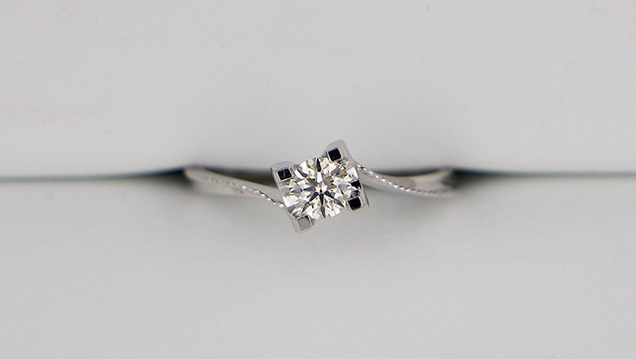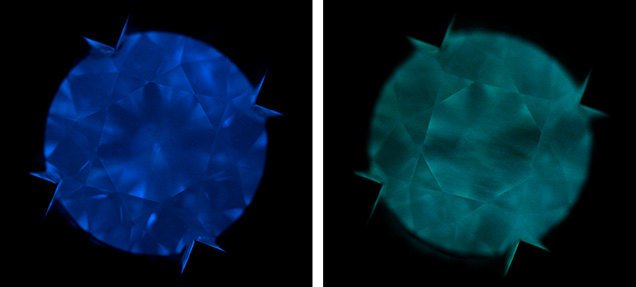Nominal Type IaB Diamond with Detectable Uncompensated Boron

In recent years, nominal type IaAB and IIa diamonds with transient 2800 cm–1 FTIR absorption peaks arising from uncompensated boron produced under UV radiation have been reported (J. Li et al., “A diamond with a transient 2804 cm–1 absorption peak,” Journal of Gemmology, Vol. 35, 2016, pp. 248–252; Winter 2016 Lab Notes, pp. 412–413). The National Center of Supervision and Inspection on Quality of Gold and Silver Products recently examined a type IaB diamond that exhibited instantaneous 2803 cm–1 FTIR absorption shortly after exposure to an ultra-short-wave (< 230 nm) UV source.


Under ultra-short-wave UV excitation, the 0.30 ct K-L diamond with faint brown color, mounted in an 18K gold prong setting (figure 1), showed strong blue fluorescence and strong greenish blue phosphorescence that lasted for approximately eight seconds (figure 2). Infrared absorption spectroscopy showed low concentrations of the hydrogen-related peak (3107 cm–1) and nitrogen impurities in the B aggregates at 1174 cm–1 (figure 3), indicating a type IaB diamond (C.M. Breeding and J.E. Shigley, “The ‘type’ classification system of diamonds and its importance in gemology,” Summer 2009 G&G, pp. 96–111); prior to ultra-short-wave UV excitation, we were unable to detect the presence of the B center. No boron-related absorption was detected before UV radiation exposure, due to uncompensated B concentrations below the detection level of the FTIR spectrometer. But shortly after ultra-short-wave UV exposure, the transient boron-related absorption peak was recorded at 2803 cm–1 (again, see figure 3). Nitrogen-related peaks were detected at 415.7, 428.5, 439.0, and 452.4 nm using photoluminescence (PL) spectroscopy (figure 4); the peak at 415.7 nm belongs to the zero-phonon line (ZPL), while the others belong to its associated phonon replicas (A.M. Zaitsev, Optical Properties of Diamond: A Data Handbook, Springer-Verlag, Berlin, 2000). PL and FTIR spectra confirmed the diamond’s natural origin.

The generally accepted mechanism for interpreting the phosphorescence in type IIb diamonds is donor-acceptor pair recombination processes involving boron and other defects (P.J. Dean, “Bound excitons and donor-acceptor pairs in natural and synthetic diamond,” Physical Review, Vol. 139, 1965, pp. A588–A602). Boron is deemed as the acceptor in the model, where the donor is believed to be nitrogen related, either as isolated nitrogen, aggregated nitrogen, or a plastic deformation–related defect (S. Eaton-Magaña and R. Lu, “Phosphorescence of type IIb diamonds,” Diamond and Related Materials, Vol. 20, 2011, pp. 983–989; E. Gaillou et al., “Boron in natural type IIb blue diamonds: Chemical and spectroscopic measurements,” American Mineralogist, Vol. 97, 2012, pp. 1–18). When almost all of the boron impurities received electrons from donors, almost no uncompensated boron (B0) was left behind, and therefore no boron-related absorption peaks were recorded. When the diamond was exposed to ultra-short-wave UV excitation, some of the compensated boron converted to an uncompensated state due to a charge transfer process between compensated boron and ionized donors, which could be recorded before the phosphorescence decayed. This mechanism is also suitable for interpreting the observed phenomenon of this specimen.
Natural diamonds with long-lasting phosphorescence under UV excitation are typically type IIb or chameleon diamonds (J.M. King et al., “Characterizing natural-color type IIb blue diamonds,” Winter 1998 G&G, pp. 246–268; T. Hainschwang et al., “A gemological study of a collection of chameleon diamonds,” Spring 2005 G&G, pp. 20–35). It is rare to find diamonds of other types, especially type IaB diamonds, showing this phenomenon. Finding a detectable, if temporary, B0 defect in a type IaB diamond is also unusual.



